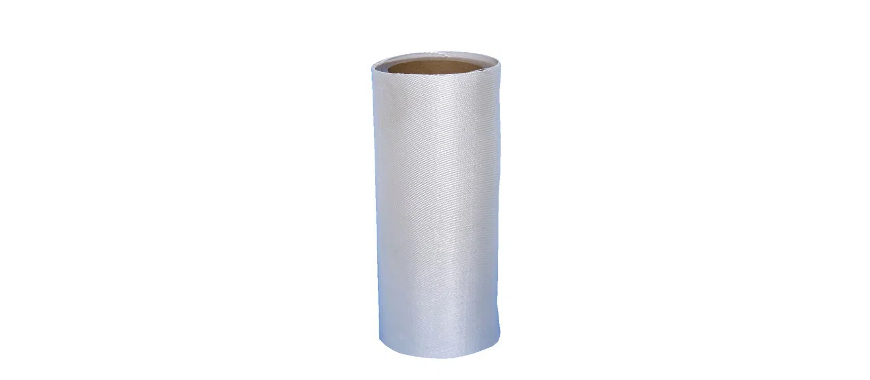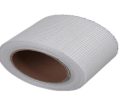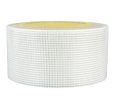
Self adhesive fiberglass mesh fabric is a versatile and durable material widely used for a variety of applications. Made from high-strength fiberglass threads, this fabric comes with a self-adhesive backing, making it easy to apply without the need for additional adhesives or tools. One of the key benefits of self adhesive fiberglass mesh fabric is its durability; it is resistant to wear and tear, UV rays, and environmental factors, making it ideal for long-term use in both indoor and outdoor settings. The fabric is also easy to use, as its self-adhesive backing allows for quick and efficient installation, even by non-professionals. It is commonly used in construction for wall repairs, home improvement for reinforcing surfaces, mosaic tiling for creating intricate designs, and waterproofing applications to prevent moisture damage. Its adaptability and strength make self adhesive fiberglass mesh fabric a popular choice in many industries.
What is Self Adhesive Fiberglass Mesh Fabric and Its Uses?
Definition
Self adhesive fiberglass mesh fabric is a highly specialized material designed to combine flexibility with exceptional durability. It is created by weaving high-strength fiberglass threads into a mesh structure, which is then coated with a pressure-sensitive adhesive. This adhesive backing is a key feature, as it allows the fabric to bond easily to surfaces without the need for additional bonding agents, such as glue or nails. As a result, the installation process is quicker, more efficient, and more convenient. The fabric is easy to handle and can be applied directly to surfaces, saving both time and effort in construction and home improvement tasks.
Construction and Materials
The primary component of self-adhesive fiberglass mesh fabric is fiberglass, which is renowned for its superior strength-to-weight ratio and its resilience in harsh environmental conditions. Fiberglass is highly resistant to heat, moisture, chemicals, and UV rays, making it an ideal material for a variety of applications where durability is crucial. The fabric is woven in a mesh pattern, allowing it to remain flexible enough to conform to irregular surfaces or complex shapes, ensuring a snug fit in any project.
This woven mesh structure combines strength and flexibility, creating a robust yet pliable material. The fiberglass threads are tightly woven to prevent tearing, stretching, or fraying during installation and use. The pressure-sensitive adhesive coating is carefully applied to the mesh, providing an instant bond to a variety of surfaces without requiring further preparation or additional adhesives. This combination of high-strength fiberglass and a durable adhesive backing makes the fabric resistant to damage and wear, extending the lifespan of the applications it is used for.
Ideal Applications
Self adhesive fiberglass mesh fabric is incredibly versatile, making it an essential material for numerous construction, renovation, and DIY projects. One of its most common uses is in drywall reinforcement, where it helps to prevent cracks and improve the durability of joint compounds. The fabric is also widely used in mosaic tiling and waterproofing applications, as it bonds securely to surfaces like tiles, concrete, and plaster. Its flexibility allows it to fit into corners, edges, and other challenging areas with ease.
In addition to its use in construction and repairs, self-adhesive fiberglass mesh fabric is frequently used for home improvement projects such as wall patching and surface repairs. It is ideal for covering cracks, holes, or damaged areas in walls and ceilings, providing a smooth and stable surface for painting or finishing. The fabric can also be used in tiling projects to reinforce the base layer and improve adhesion between tiles and the substrate.
This mesh fabric is especially popular among both professional contractors and DIY enthusiasts. Its easy-to-apply nature eliminates the need for messy adhesives, simplifying the installation process. Whether reinforcing a surface, waterproofing a structure, or creating a solid foundation for tiles, self-adhesive fiberglass mesh fabric delivers a reliable and efficient solution for a wide range of applications.
Fiberglass Rebar Detailing: Key Considerations for Installation
Applications of Self-Adhesive Fiberglass Mesh Fabric in Various Industries
Waterproofing with Self-Adhesive Mesh Tape
Self adhesive fiberglass mesh fabrics is widely used in waterproofing applications, particularly in areas that are prone to high moisture levels, such as showers, bathrooms, and basements. The fabric, often in the form of mesh tape, plays a crucial role in creating a seamless, durable barrier between waterproofing materials and the surfaces they cover. By offering a reliable bond, the mesh ensures that the waterproofing layer adheres firmly, preventing leaks and moisture infiltration.
Key Benefit
- Mold Resistance: The fiberglass material resists mold and mildew growth, making it an excellent choice for damp environments like bathrooms or basements where moisture is a constant concern.
- Long-Lasting Protection: Thanks to its strength and durability, self adhesive fiberglass mesh fabrics provides long-term protection against water damage, ensuring that surfaces remain dry and free from leaks for years.
- Ease of Installation: The self-adhesive backing of the mesh tape simplifies the installation process. No additional bonding agents are needed, and the fabric can be applied directly to the surface, saving time and effort.
- Strong Bond: The mesh tape’s adhesive provides a strong, long-lasting bond with various waterproofing materials, enhancing the effectiveness of the waterproofing system and ensuring a tight seal.
Whether used in residential renovations or large-scale construction projects, self adhesive fiberglass mesh fabrics helps deliver a robust, moisture-resistant layer that stands the test of time, preventing water-related issues in critical areas of a building.
Top Fiberglass Rebar Distributors for Construction Projects
Self Adhesive Fiberglass Mesh Fabric for Concrete Reinforcement
Self-Adhesive Fiberglass Mesh Fabric for Concrete Strengthening
Self adhesive fiberglass mesh fabrics is an essential material used for concrete reinforcement in various construction applications. It is particularly effective in strengthening concrete joints, cracks, and repairs, where additional reinforcement is needed to ensure long-lasting durability. The mesh is typically embedded in the surface of concrete, acting as a supportive layer that enhances its structural integrity.
Key Benefits
- Reduces Cracking: Concrete is prone to cracking due to environmental factors, temperature changes, and movement. Self adhesive fiberglass mesh fabric helps prevent cracks from spreading by providing additional support across the surface. The mesh evenly distributes stress and pressure, reducing the likelihood of cracks forming.
- Increases Durability: By reinforcing concrete, the mesh fabric helps increase its overall durability and lifespan. It improves the material’s resistance to wear, water damage, and mechanical stresses, making it ideal for both residential and commercial applications.
- Effective for Repairs: When repairing existing concrete surfaces, self adhesive fiberglass mesh fabric ensures that the new concrete bonds effectively to the old material, creating a stronger, more cohesive structure.
- Versatility: This reinforcement material can be used in a wide range of concrete applications, from driveways, floors, and foundations to sidewalks and parking lots. It’s also ideal for commercial construction projects, including high-traffic areas that require extra durability.
Incorporating self adhesive fiberglass mesh fabric in concrete reinforcement not only enhances the strength and longevity of the material but also reduces maintenance costs by improving the overall performance of concrete surfaces. Whether used for new construction or as part of a repair project, this fabric provides a cost-effective, reliable solution for concrete reinforcement.
Why Fiberglass Rebar for Bank Poles is the Best Choice
Advantages of Using Self-Adhesive Fiberglass Mesh Fabric for Various Applications
Key Benefits of Self-Adhesive Fiberglass Mesh Fabric
Self adhesive fiberglass mesh fabric offers several advantages that make it a preferred material for a wide range of applications. Its unique properties provide solutions for both simple and complex projects, making it an indispensable choice for professionals and DIY enthusiasts alike. Here are some of the key benefits:
Key Advantages
- Ease of Use: One of the standout benefits of self adhesive fiberglass mesh fabric is its simplicity of application. Unlike other reinforcement materials that require additional adhesives, fasteners, or complicated installation techniques, this mesh fabric features a peel-and-stick design. This means it can be easily applied to surfaces, saving both time and effort during installation.
- Durability: Self adhesive fiberglass mesh fabric is designed for long-lasting performance. It is particularly effective in areas that are exposed to moisture, frequent wear, or environmental stress. Whether used in bathrooms, basements, or construction sites, the fabric resists wear and tear, mold, and mildew, ensuring reliable protection and reinforcement over time.
- Versatility: Another significant advantage of self adhesive fiberglass mesh fabric is its versatility. It can be used in a variety of applications, from drywall repairs to mosaic tiling, waterproofing, and even concrete reinforcement. This adaptability makes it suitable for both residential and commercial projects, including construction, home improvement, and industrial applications.
- Enhanced Bonding: The self-adhesive backing ensures that the fabric adheres firmly to surfaces, creating a strong bond with joint compounds, tiles, concrete, and more. This bonding helps improve the overall strength and durability of the materials it is applied to.
- Cost-Effective: Since no additional adhesives or tools are required, self adhesive fiberglass mesh fabric is a cost-effective option. Its ease of installation reduces labor costs and simplifies the application process, especially for DIY projects.
Whether you’re working on a small repair, a large construction job, or waterproofing needs, self adhesive fiberglass mesh fabric provides a durable, easy-to-use, and versatile solution that ensures long-term performance and reliability.
How to Use Self-Adhesive Fiberglass Mesh Fabric
Step-by-Step Guide for Applying Self-Adhesive Fiberglass Mesh Fabric
Using self adhesive fiberglass mesh fabric is simple, but following the proper steps ensures the best results, whether you’re using it for concrete repair, tiling, or waterproofing. Below is a step-by-step guide on how to apply this fabric in various scenarios.
Concrete Repair
- Surface Preparation: Begin by cleaning the concrete surface to remove any loose debris, dirt, or dust. Ensure that the surface is smooth and dry for optimal adhesion of the fabric.
- Measure and Cut: Measure the area that needs reinforcement and cut the self adhesive fiberglass mesh fabric to size using scissors or a utility knife. Make sure the fabric overlaps any cracks or joints by at least 1-2 inches on each side.
- Apply the Mesh: Peel the backing off the fabric and press it onto the concrete, ensuring it adheres firmly to the surface. Smooth out any wrinkles or air bubbles.
- Cover with Repair Material: Once the mesh is in place, cover it with a thin layer of concrete or joint compound. Allow it to dry fully before adding additional layers or finishing the repair.
Tiling
- Prepare the Surface: Clean the surface to ensure it is dry, free of dust, and smooth. If needed, apply a primer to help the adhesive stick better.
- Cut the Mesh: Measure and cut the self adhesive fiberglass mesh fabric to fit the tiling area.
- Install the Mesh: Peel off the backing and press the fabric directly onto the surface, ensuring it sticks without bubbles or wrinkles.
- Apply Thinset: Spread a layer of thinset over the fabric before laying the tiles. The mesh acts as reinforcement to prevent cracking and provides a stronger bond for the tiles.
Waterproofing
- Prepare the Surface: Ensure that the surface is clean and dry. For better adhesion, consider priming the area with a bonding agent.
- Cut the Mesh to Size: Measure the area to be waterproofed and cut the self adhesive fiberglass mesh fabric to the required size.
- Apply the Mesh: Peel the backing off and press the fabric onto the surface, making sure it adheres well. Ensure the mesh is applied smoothly without any gaps or wrinkles.
- Apply Waterproofing Material: Once the mesh is in place, apply the waterproofing material, such as a liquid membrane, over the fabric. Allow it to cure according to the product instructions.
Tips for Achieving Optimal Results
- Surface Preparation: Thoroughly clean the surface before applying the self adhesive fiberglass mesh fabric. Removing dirt, oil, and moisture will ensure that the fabric adheres properly and provides maximum effectiveness.
- Use Proper Tools: For cutting, use sharp scissors or a utility knife to ensure clean, precise edges. When smoothing out the fabric on the surface, use a roller or a flat tool to remove air bubbles and ensure even adhesion.
- Apply in Layers: If you’re applying the fabric in multiple layers (e.g., for concrete repair), make sure each layer dries completely before applying the next. This ensures the fabric is fully embedded in the material, offering the maximum benefit in terms of strength and durability.
- Finishing: Once you’ve applied the fabric and any additional materials, allow everything to cure fully. Follow the manufacturer’s recommendations for drying times and finishing processes to ensure the best long-term results.
By following these steps and tips, you can ensure the self adhesive fiberglass mesh fabric works effectively, whether you are reinforcing concrete, tiling, or waterproofing. Its ease of use and strong performance make it a valuable material in any project.
FAQs about Self Adhesive Fiberglass Mesh Fabric
Sticking fiberglass mesh is simple and requires a few basic steps. The most common method is using the self-adhesive backing found on many fiberglass mesh products. For mesh tapes, peel off the protective backing to reveal the adhesive surface and apply it directly to the surface you want to reinforce, such as drywall or concrete. Ensure that the surface is clean, dry, and free of dust or oil for optimal adhesion. Once the mesh is in place, you can apply joint compound or plaster over it, smoothing out any air bubbles or wrinkles. If you’re using non-adhesive fiberglass mesh, you’ll need to apply a thin layer of adhesive or joint compound first, then press the mesh onto the surface, making sure it’s properly embedded in the material.
While mesh tape offers many benefits, it does have some disadvantages. First, it can be more difficult to work with than traditional paper tape, especially for beginners. Its adhesive backing can sometimes be too sticky, making it hard to reposition if placed incorrectly. Additionally, in high-moisture areas like bathrooms or kitchens, mesh tape may not bond as effectively without additional support or adhesives. Over time, if not properly embedded in joint compound, mesh tape can lead to visible bulges or cracks as the material shifts. Finally, while it’s excellent for drywall joints, it may not be suitable for all types of repairs, such as those requiring heavier reinforcement or for areas with high stress or movement.
Fiberglass mesh tape is a versatile material primarily used for reinforcing drywall joints, cracks, and seams in construction and renovation projects. It is often applied in the first step of drywall finishing, as it strengthens the joint compound applied over it, preventing cracks from reappearing. Mesh tape is also commonly used for repairs in concrete or masonry walls, where it helps bond and reinforce weak areas. Additionally, fiberglass mesh tape is effective for waterproofing applications, as it can be used with joint compounds to create a waterproof seal. It’s also used in tiling projects to prevent tile cracking and to provide stability for tiled surfaces. In some cases, mesh tape is employed in mosaic work, offering both flexibility and durability.
Fiberglass mesh tape is generally stronger than traditional paper tape, particularly when it comes to drywall applications. This is because the fiberglass threads provide added strength and flexibility, making it more resistant to tearing and damage. The mesh design also prevents the tape from stretching, providing consistent support to the joint compound applied over it. Unlike paper tape, which can tear or crease under pressure, fiberglass mesh tape holds up better in high-stress areas, offering better reinforcement for drywall joints, corners, and cracks. However, paper tape is often preferred for its smooth finish and ease of use in professional settings, as it creates a less noticeable seam when covered with joint compound. Therefore, while fiberglass mesh tape is stronger in terms of reinforcement, paper tape may be a better option for a smoother finish.

As the editor of GangLong Fiberglass, I have years of experience and in-depth research, focusing on cable tray products, fiberglass solutions, and grille systems. I incorporate years of industry insights and practical experience into every content, committed to promoting the progress of the industry. At GangLong Fiberglass, my commitment is reflected in every product, from innovative cable trays to durable fiberglass solutions and sturdy grille systems. As an authoritative voice in the industry, my goal is to provide valuable information to professionals and businesses and promote forward-looking solutions.


